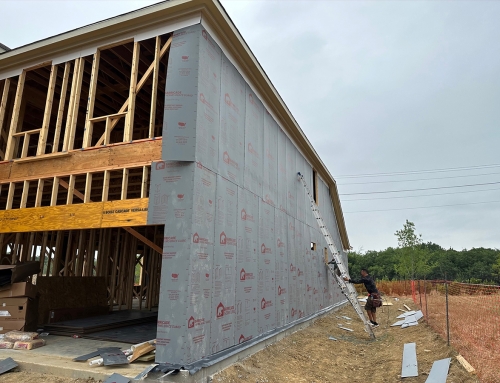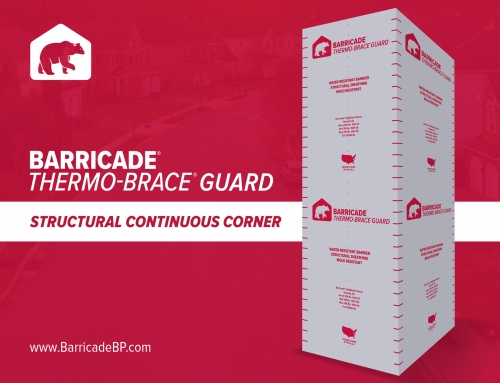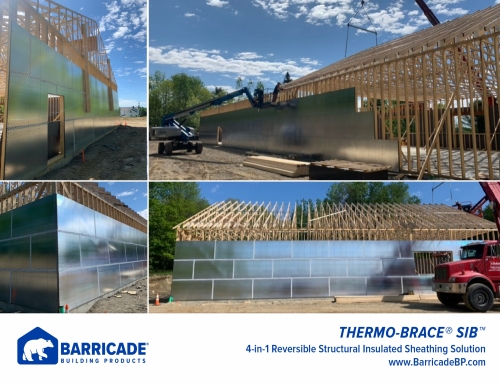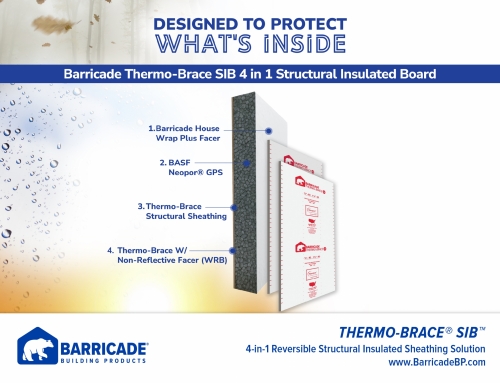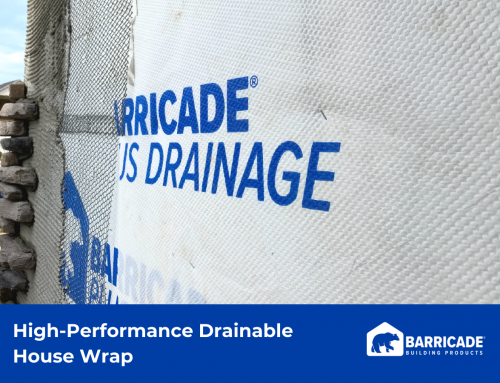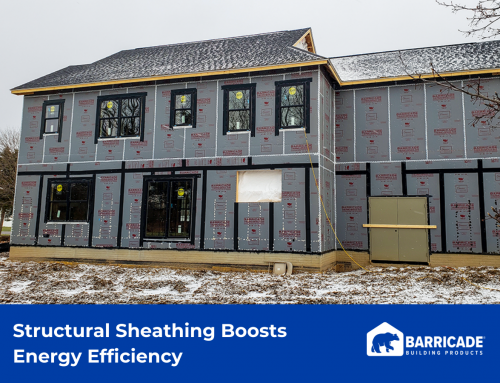When designing for energy-efficiency, building science emphasizes the importance of a continuous air barrier system to control the transfer of heat, moisture, and air. A superb air barrier that building scientists can include in the design of an energy-efficient structure is Barricade® Building Wrap. Barricade® Building Wraps provide airtightness and moisture resistance, which are key components of a building science design for an energy-efficient home or building.
Understanding Building Science When Designing an Energy-Efficient Building
Constructing a modern, energy-efficient building requires an understanding of building science. When designing a structure, building scientists consider how physics, chemistry, biology, and climatology impact the energy efficiency, durability, comfort, and indoor air quality (IAQ) of a home or building.
Building Physics Requires the Use of Air Barriers in Energy-Efficient Construction
Building physics is a design discipline that focuses on the complex interaction of air, heat, and moisture flows inside and across the building enclosure. Building physics consider occupant comfort, energy use, carbon emissions, and operational performance. Building physic scientists utilize a range of analytical tools including modeling of moisture, airflow, and temperature to construct a healthy, comfortable, and energy-efficient building or home.
When designing an energy-efficient structure, a vital component of building physics is the application of a continuous airtight barrier system. The continuous air barrier system provides an airtight building envelope that separates the unheated and heated spaces. The continuous air barrier system includes the flexible sealed joints, interconnected materials, and an air barrier, like the Barricade® Building Wraps.
The Building Physics of Barricade® Building Wraps
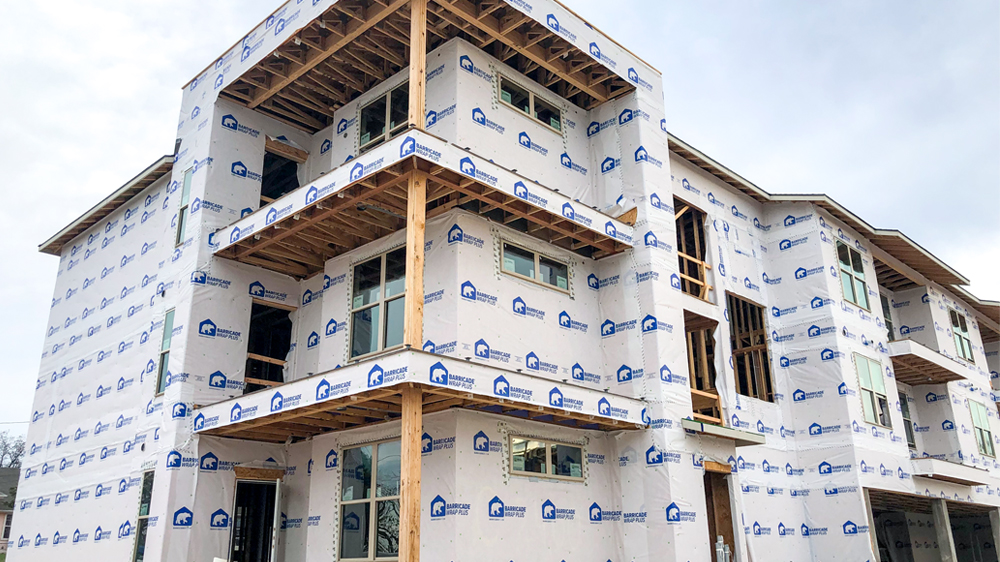
Barricade® Building Wraps ensure the comfort and health of the occupants of a building or home by creating a continuous airtight barrier system, an essential element in building physics design. Application of Barricade® Building Wraps ensures the energy efficiency, integrity and indoor air quality of a building. Notably, Barricade® Building Wraps meet and exceed the requirements of the 2018 IECC R402.4.1 and C402.5.
Building Biology Requires the Use of Vapor Permeable Air Barriers for Energy-Efficient Design
Building biology is a discipline that aims for natural, healthy ecological schools, homes, and workplaces that are also good for the environment. To ensure the health of both the occupants and environment, building biologists consider many factors when choosing materials and construction methods, including vapor permeability.
Vapor permeability is essential for preventing a buildup of moisture within a wall system. When designing a moisture-resistant home or building, a critical component of building biology is the application of a vapor-permeable air barrier.
A vapor permeable air barrier controls indoor air quality by ensuring evaporation of the moisture within the wall system and preventing infiltration of pollutants; both of which are unhealthy to the occupants of the building. A buildup of moisture within a wall assembly can cause mold and rot.
Mold diminishes the indoor air quality of a building by producing irritants and allergens. Rot can destroy the integrity of a building or home. A critical building biology concept that ensures a healthy indoor environment is a vapor-permeable air barrier, like Barricade® Building Wraps.
The Building Biology of Barricade® Building Wraps
Barricade® Building Wraps are an excellent building biology design choice. Barricade® Building Wraps are permeable air barriers that stop air infiltration and allow moisture to evaporate, which contributes to a healthy indoor environment and ensure the durability of the structure.
- Barricade® Building Wraps are highly air resistant and permeable to vapor, which ensures a comfortable, healthy, and energy-efficient structure.
- Barricade® Building Wrap maintains its integrity before and after installation which limits moisture intrusion.
- Barricade® Wrap withstands 12 months of UV-exposure without damage occurring.
- Barricade® Wrap has a tear-stop design with superior strength.
Building Climatology Considers Local Conditions for Optimizing an Energy-Efficient Design
Building climatology is the scientific study of climates, over a long period, with regards to building design. Specifically, building climatology strives to ensure that the building and the geographical environment are in unity so to achieve maximum user comfort and energy-efficiency.
The five major climatic elements affecting the design of a building are temperature, humidity, wind, atmospheric pressure, and precipitation. Architects and builders of energy-efficient structures consider several design options related to building climatology, for example:
- Passive solar building design utilizes the sun’s daily and annual cycles to maintain the interior thermal comfort and reduce energy use for heating and cooling systems.
- Daylighting is the placing of glazing elements to maximize natural lighting and reduce the use of energy due to illumination.
- Building and room orientation are crucial to taking advantage of the sun’s energy. For instance, in the northern hemisphere, north-south orientation of houses lessens direct sunlight during the summer (which reduces cooling demands) and maximizes sunlight during the colder months (which lowers heating demands).
- Ventilation (both natural and mechanical) is essential for controlling the movement of air and moisture with a building and between the structure and outside.
- Building the climatology design of an energy-efficient house includes energy-efficient doors, windows, and skylights appropriate to the climate zone.
- Building climatology design must also consider the amount of rainfall and risk of natural disasters like hurricanes and fires as related to climate.
Building Chemistry for an Energy-Efficient Design
Chemistry determines the composition, structure, and properties of building materials. Chemistry traits of building materials include its density, reflectiveness, adhesiveness, viscosity, and thermal properties. These traits keep homes and buildings durable, energy efficient and comfortable. Building chemistry plays a significant role in the selection of construction materials, for example:
- Continuous insulation (CI): Building chemistry developed the use of thermosets as the primary insulator for CI in modern high-performing buildings. Thermosets are plastics like polyurethane foam and thermoplastic foams (polystyrene, extruded polystyrene, or expanded polystyrene) that significantly improve the material’s mechanical properties. Thermosets enhance the chemical resistance, heat resistance, and structural integrity of building products.
- Roofing: Chemistry helped to develop energy-efficient, highly reflective roof coatings made from silicones, acrylics, urethanes, silicones, and styrene block copolymers (such as SBS and SEBS). The use of these products can lengthen the life of a roof, help reduce air leaks, lessen heat transfer and reduce the thermal shock that happens when the layers of the roof expand and contract.
Building science considers many topics when designing a high-performing, energy-efficient building, including building physics, biology, chemistry, and climatology. Essential to building science design for an energy-efficient building is a continuous air barrier system to control the transfer of heat, moisture, and air.
A superb product that building scientists can include in the design of an energy-efficient structure is Barricade® Building Wrap. Barricade®> Wrap provides a moisture permeable, air barrier, which is a vital component of a building science design for energy-efficient construction.


